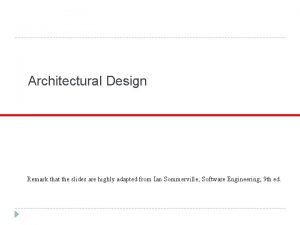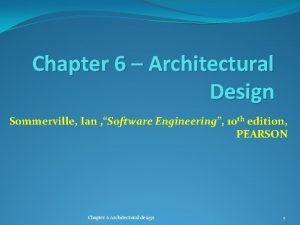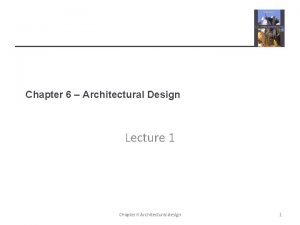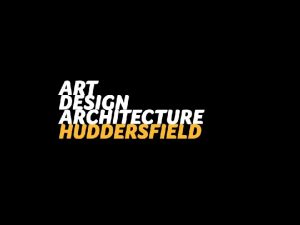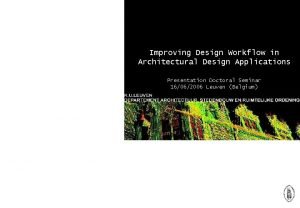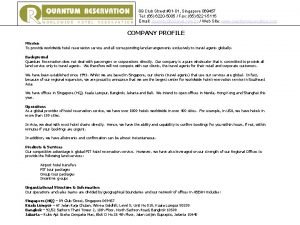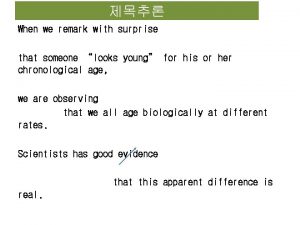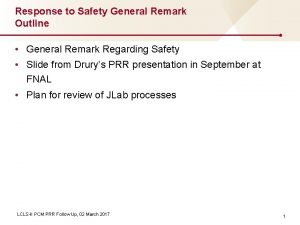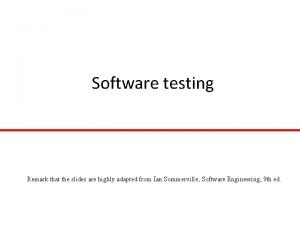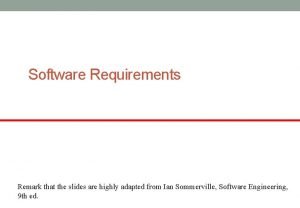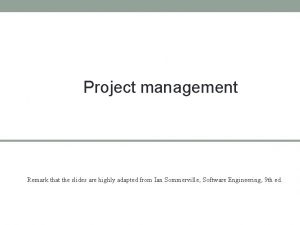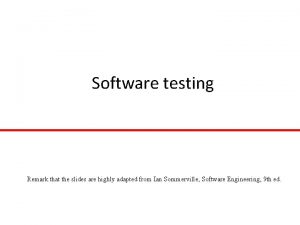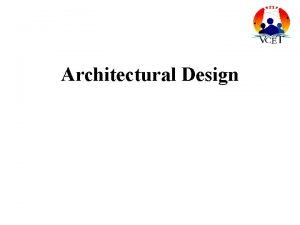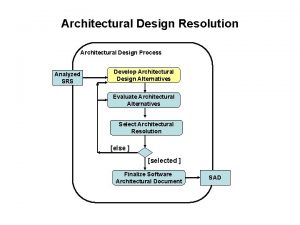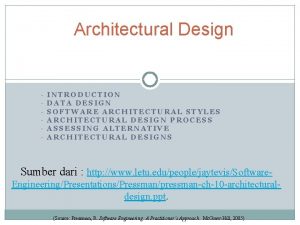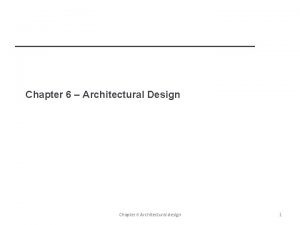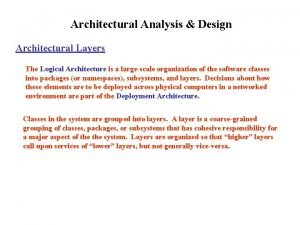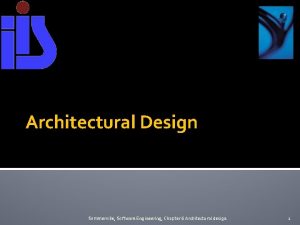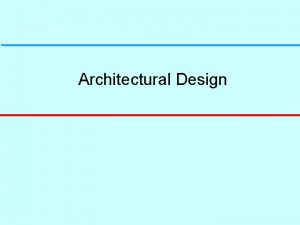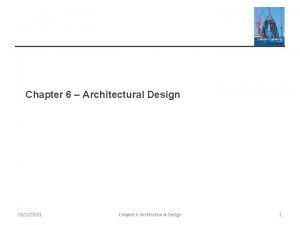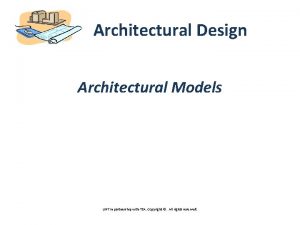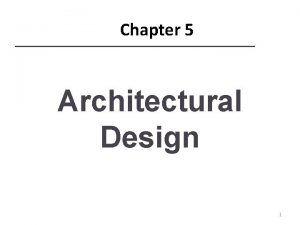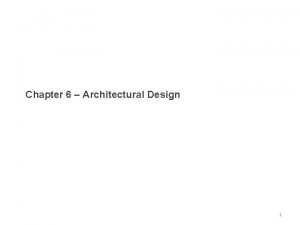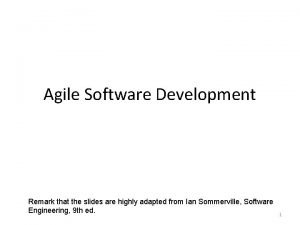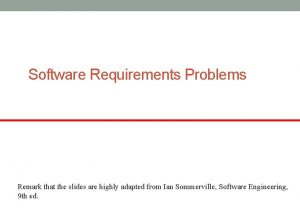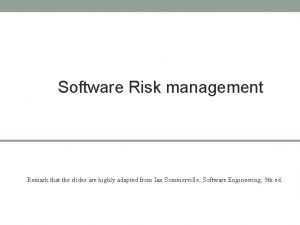Architectural Design Remark that the slides are highly

























- Slides: 25

Architectural Design Remark that the slides are highly adapted from Ian Sommerville, Software Engineering, 9 th ed.

Architectural design An early stage of the system design process. Represents the link between specification and design processes. Often carried out in parallel with some specification activities. It involves identifying major system components and their communications.

Advantages of explicit architecture Stakeholder communication System analysis Architecture may be used as a focus of discussion by system stakeholders. Means that analysis of whether the system can meet its non-functional requirements is possible. Large-scale reuse The architecture may be reusable across a range of systems.

Architecture and system characteristics Performance Security Localise safety-critical features in a small number of sub-systems. Availability Use a layered architecture with critical assets in the inner layers. Safety Localise critical operations and minimise communications. Use large rather than fine-grain components. Include redundant components and mechanisms for fault tolerance. Maintainability Use fine-grain, replaceable components.

Architectural conflicts Using large-grain components improves performance but reduces maintainability. Introducing redundant data improves availability but makes security more difficult. Localising safety-related features usually means more communication so degraded performance.

System structuring Concerned with decomposing the system into interacting sub-systems. The architectural design is normally expressed as a block diagram presenting an overview of the system structure. More specific models showing how sub-systems share data, are distributed and interface with each other may also be developed.

Packing robot control system

Architectural design decisions Architectural design is a creative process so the process differs depending on the type of system being developed. However, a number of common decisions span all design processes.

Architectural design decisions Is there a generic application architecture that can be used? How will the system be distributed? What architectural styles are appropriate? What approach will be used to structure the system? How will the system be decomposed into modules? What control strategy should be used? How will the architectural design be evaluated? How should the architecture be documented?

Architectural styles The architectural model of a system may conform to a generic architectural model or style. An awareness of these styles can simplify the problem of defining system architectures. However, most large systems are heterogeneous and do not follow a single architectural style.

System organisation Reflects the basic strategy that is used to structure a system. Three organisational styles are widely used: A shared data repository style; A shared services and servers style; An abstract machine or layered style.

The repository model Sub-systems must exchange data. This may be done in two ways: Shared data is held in a central database or repository and may be accessed by all sub-systems; Each sub-system maintains its own database and passes data explicitly to other sub-systems. When large amounts of data are to be shared, the repository model of sharing is most commonly used.

CASE toolset architecture

Repository model characteristics Advantages Efficient way to share large amounts of data; Sub-systems need not be concerned with how data is produced Centralised management e. g. backup, security, etc. Sharing model is published as the repository schema. Disadvantages Sub-systems must agree on a repository data model. Inevitably a compromise; Data evolution is difficult and expensive; No scope for specific management policies; Difficult to distribute efficiently.

Client-server model Distributed system model which shows how data and processing is distributed across a range of components. Set of stand-alone servers which provide specific services such as printing, data management, etc. Set of clients which call on these services. Network which allows clients to access servers.

Film and picture library

Client-server characteristics Advantages Distribution of data is straightforward; Makes effective use of networked systems. May require cheaper hardware; Easy to add new servers or upgrade existing servers. Disadvantages No shared data model so sub-systems use different data organisation. Data interchange may be inefficient; Redundant management in each server; No central register of names and services - it may be hard to find out what servers and services are available.

Abstract machine (layered) model Used to model the interfacing of sub-systems. Organises the system into a set of layers (or abstract machines) each of which provide a set of services. Supports the incremental development of sub-systems in different layers. When a layer interface changes, only the adjacent layer is affected. However, often artificial to structure systems in this way.

Version management system

Modular decomposition styles Styles of decomposing sub-systems into modules. No rigid distinction between system organisation and modular decomposition.

Sub-systems and modules A sub-system is a system in its own right whose operation is independent of the services provided by other sub-systems. A module is a system component that provides services to other components but would not normally be considered as a separate system.

Modular decomposition Another structural level where sub-systems are decomposed into modules. Two modular decomposition models covered An object model where the system is decomposed into interacting object; A pipeline or data-flow model where the system is decomposed into functional modules which transform inputs to outputs. If possible, decisions about concurrency should be delayed until modules are implemented.

Object models Structure the system into a set of loosely coupled objects with well-defined interfaces. Object-oriented decomposition is concerned with identifying object classes, their attributes and operations. When implemented, objects are created from these classes and some control model used to coordinate object operations.

Invoice processing system

Object model advantages Objects are loosely coupled so their implementation can be modified without affecting other objects. The objects may reflect real-world entities. OO implementation languages are widely used. However, object interface changes may cause problems and complex entities may be hard to represent as objects.
 Insidan region jh
Insidan region jh Remark slides
Remark slides Phân độ lown ngoại tâm thu
Phân độ lown ngoại tâm thu Block av độ 2
Block av độ 2 Thể thơ truyền thống
Thể thơ truyền thống Thơ thất ngôn tứ tuyệt đường luật
Thơ thất ngôn tứ tuyệt đường luật Walmart thất bại ở nhật
Walmart thất bại ở nhật Tìm vết của mặt phẳng
Tìm vết của mặt phẳng Hãy nói thật ít để làm được nhiều
Hãy nói thật ít để làm được nhiều Tôn thất thuyết là ai
Tôn thất thuyết là ai Gây tê cơ vuông thắt lưng
Gây tê cơ vuông thắt lưng Sau thất bại ở hồ điển triệt
Sau thất bại ở hồ điển triệt A small child slides down the four frictionless slides
A small child slides down the four frictionless slides Energy conservation quick check
Energy conservation quick check Architectural design in software engineering
Architectural design in software engineering Architectural design
Architectural design Architectural design in huddersfield
Architectural design in huddersfield Design objectives architecture example
Design objectives architecture example Airline reservation system project ppt
Airline reservation system project ppt Architectural design workflow
Architectural design workflow In line 2 impatient of is best interpreted as meaning
In line 2 impatient of is best interpreted as meaning Why was brian traveling in a bush plane
Why was brian traveling in a bush plane Paul remarque
Paul remarque Remark gatekunst
Remark gatekunst When we remark with surprise that someone
When we remark with surprise that someone Remark test grading cloud
Remark test grading cloud

